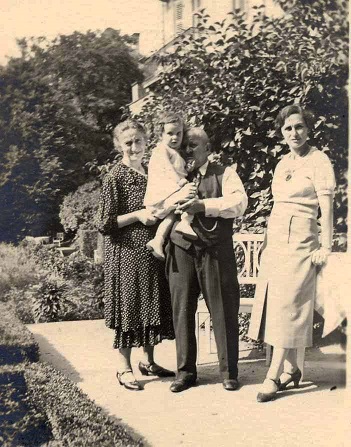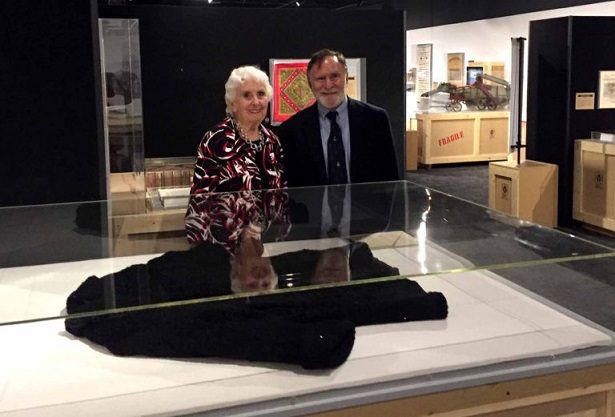Today is National Holocaust Remembrance Day. While the Holocaust might seem many decades and thousands of miles from Nebraska, we preserve objects and memories so people in the present will not forget the horror and injustice of the past. This is the story of a coat and the families who wore it, saved it, buried it, cleaned it, wore it again, and, most importantly, preserved and documented it.

Left to right: Hedwig Rosenberg, Hanna in the arms of Benno Rosenberg, and Ilse Speier Rosenberg (Hanna’s mother). This is one of a series of photos taken in Bad Kissingen, Germany, on 8 August 1937, the last time Hanna saw her paternal grandparents. Hanna left Germany later in August 1937 with her parents. This image is from the collection of Hanna and David Gradwohl.
Life was good for Hedwig and Bernhard “Benno” Rosenberg of Frankfurt, Germany, in the early 1930s. Their department store was a popular shopping destination and they enjoyed a comfortable lifestyle with their son Ludwig, his wife Ilsa, and their baby granddaughter Hanna. Hedwig (Speyer) Rosenberg was born on August 20, 1874, in Völkershausen, Thüringen. For many years, she co-owned the fashion department store S. Speyer KG in Sonneberg, Germany. After she and Benno married, they had two sons, Fritz and Ludwig Ernst. The Nazi party came to power in 1933, making Adolf Hitler the new Chancellor of Germany. Hitler called for a boycott of Jewish owned shops and businesses. The Rosenbergs’ finances suffered, but they remained optimistic and hoped for the best. Ludwig Rosenberg’s father-in-law, Alfred Speier, was also a Jewish business owner (he owned the upscale “Speier’s” fabric store in Halberstadt). Speier lamented the boycotts to a Nebraska cousin with whom he had corresponded with since childhood. Sometime in the mid-1930s, Alfred met his cousin in Switzerland. After reading uncensored newspapers, he began to realize the danger his family was in. In a 1996 interview, Alfred Speier’s youngest daughter, Eva, explained that most Jewish people living in Germany in the 1930s were unaware of the danger. “The papers were censored, we had no idea and of course when you lived in Germany, you thought you lived in a civilized country with these great philosophers.” Alfred’s cousin offered to help the Speiers escape to the United States. Alfred sold his fabric store and in December 1936, moved with his wife, Kate, and 16-year-old daughter Eva to Lincoln, Nebraska, where they settled in a house at 16th & B Streets. Eva attended University High School. Later in her life, she recalled the challenges of being a new immigrant. In addition to her struggle to learn English, her winter coat caused other teens to stare. The coat, lined with hamster pelts, had been an expensive and fashionable item back home, but was one of many things that made her feel like she didn’t fit in. For the first half of 1937, the Speiers waited nervously for their daughter Ilsa, her husband Ludwig, and their daughter Hanna to join them in Nebraska. Conditions for Jews in Germany had deteriorated and anti-Semitic laws and sentiment resulted in violence towards Jewish citizens. Eva remembered that “it was a very difficult month waiting whether they would get out.” Finally in August 1937, Ilse, Ludwig, Ilsa, and Hanna arrived in Lincoln and moved in with the Speiers. Ludwig got a job working at Gold’s Department store as a buyer. Hedwig and Benno, Ludwig’s parents, remained in Frankfurt. Despite frantic efforts to help them escape via Cuba, Hedwig and Benno Rosenberg did not make it out. They continued living in Frankfurt until September 2, 1942.

The photo shows Hedwig’s husband, Bernhard “Benno” Rosenberg (right) and her brother Julius Speyer (left) and Hedwig (seated). The three lived together in Sonneberg and later in Frankfurt, where they were living when the Nazis deported them to Theresienstadt. This image is from the collection of Hanna and David Gradwohl.
On that autumn morning, Hedwig arrived at the doorstep of a trusted non-Jewish neighbor’s house carrying several of her treasured possessions. She may have known that she was about to be taken away from her home and had perhaps watched as the Nazis looted the possessions of other Jewish families. One of the things she carried that day was her black Persian lamb coat. The full-length coat was at the height of 1930s fashion and would have kept her warm all winter. The neighbor, fearful of the looting and violence in Frankfurt, buried the coat in her backyard for safekeeping. The Nazis came for the Rosenbergs and Hedwig’s brother Julius Speyer, who was also part of their household, later that day. They were put on a train headed to the Theresienstadt Jewish ghetto located in what is now the Czech Republic. From there, they were taken to Treblinka extermination camp in Poland. On September 29, 1942, the Nazis murdered Hedwig and Benno. The Nazis murdered Julius on November 28, 1942. Before the war ended, 850,000 men, women, and children were killed at Treblinka. One day, after the end of World War II, a large package arrived at the house on 16th & B Streets. The package contained the Persian lamb coat. The Rosenbergs’ neighbor had unearthed Hedwig’s beloved coat from her yard and mailed it to Lincoln. Ilsa had her mother-in-law’s coat cleaned and repaired at Mack Pachman’s Furrier in downtown Lincoln. She remembered Hedwig every time she wore the coat. Eventually she donated it to the Nebraska State Historical Society, along with a collection of household items the Speier and Rosenberg families brought with them when they escaped Germany.

Siblings Hanna (Rosenberg) Gradwohl and John Rosenberg stand next to their grandmother Hedwig Speyer Rosenberg’s Persian lamb coat at the Nebraska History Museum. Hanna traveled from Ames, Iowa, and John traveled from Madison, Wisconsin, to attend the museum’s grand re-opening.
Hedwig’s granddaughter Hanna (Rosenberg) Grandwohl now lives in Ames, Iowa, with her husband David. The Gradwohls made a special trip to visit the museum and see the coat on exhibit during the Nebraska History Museum’s opening weekend. They wrote the following: Hanna and I thoroughly enjoyed our weekend in Lincoln for the re-opening of the NSHS Museum…I would also like to say how much Hanna and I enjoyed the presentations on Saturday and Sunday afternoons. It was gratifying and instructive to see the celebration of the diversity of Nebraskans in terms of national origin, race, and ethnicity – – especially in the face of the xenophobia and hate being expressed in some quarters of our nation. Again, our thanks to you and all the NSHS staff for the wonderful new exhibits and the fine schedule of events over the weekend. Cordially, David & Hanna Gradwohl The items in the Rosenberg/Speier collection help tell the story of two families who immigrated to Nebraska under horrific circumstances and started new lives. But Hedwig Rosenberg’s Persian lamb coat is also a reminder of a life – and over six million other lives – cut short. — Tina Koeppe, Exhibit Curator and Coordinator and Kylie Kinley, Assistant Editor



